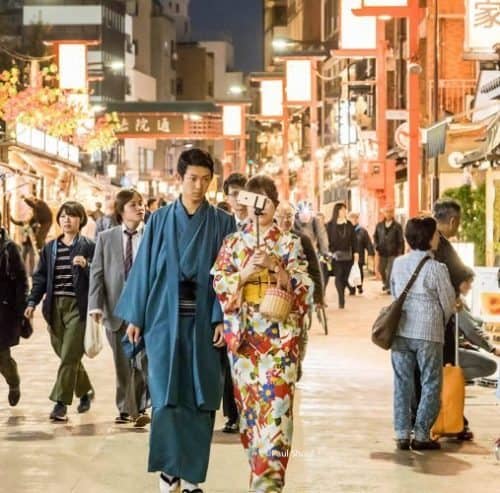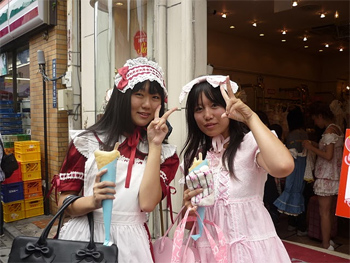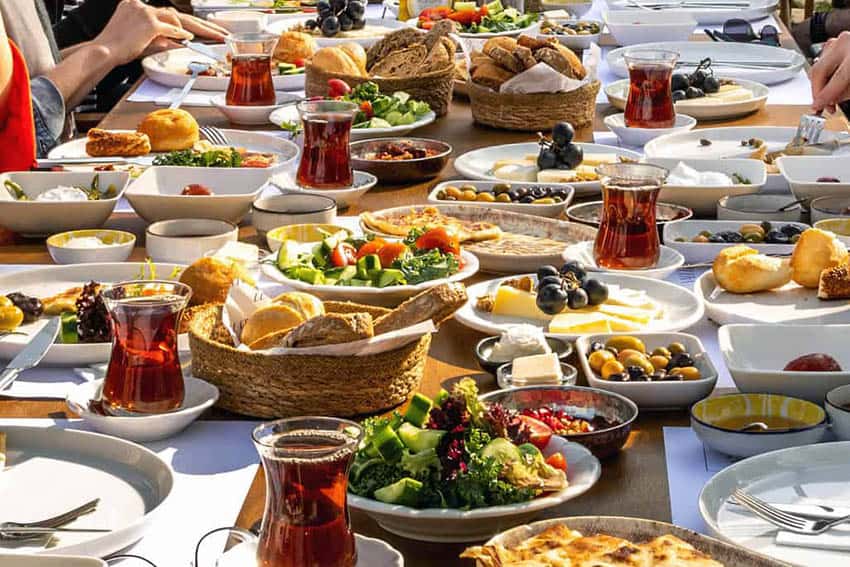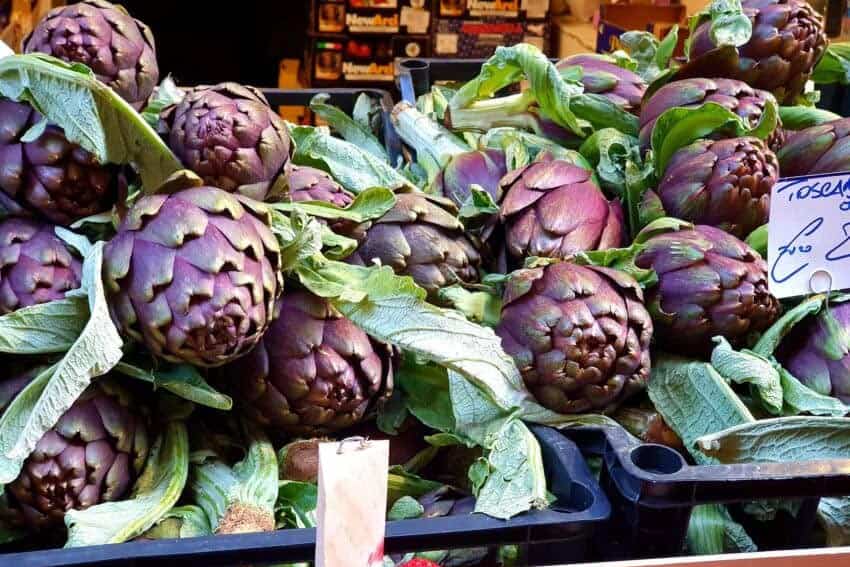
Your Must-Know Tokyo Neighborhood Guide
By Grace Gravel
Upon exiting the JAL plane and walking toward passport control, I have my first encounter with Japanese signs in form of a signboard featuring the word “Okaerinasai” (Welcome home) in Japanese Hiragana at the entrance hall.

Joining in a group picture with the welcoming signboard, I try to convince myself that I really am in Japan –- the country of samurai, mangas, and sushi.
Although I had plenty of time on the plane to get myself accustomed to the idea that I would be spending three weeks in Japan with a cultural exchange organization, I still could not realize that I had finally made it to Tokyo.
On the way to Yoyogi Memorial Youth Center, where my group mates and I would stay for two weeks, our bus crossed Tokyo from east to west, giving us an extraordinary first impression of its monstrous size and its versatile architecture.
While entering the city from Narita Airport gave us the impression that Tokyo hosted quite a number of smaller and older buildings, as we progressed into the busy city center, those buildings became a rare sight until completely vanishing in favor of an urban landscape.
Taking in the exoticness that irradiated from outside our bus, I was as dazzled as the other group members, although this was technically not my first time in Tokyo.
It is true that I spent a few years living and going to school in Tokyo, but that was too long ago and all I remember are fractions of memorable events.

When I told a friend I would be going to Tokyo, he told me I would either hate or love Japan’s largest city.
He was convinced of this because, first of all, unlike other cities, Tokyo, its people, and their mentalities are not at all easy to comprehend, posing a challenging task for those who want to integrate themselves into Japanese life.
Further, one has to like, or at least not mind, crowded subways, tiny apartments, and dizzying modern skyscrapers, to mention a few matters.
However, right there on the bus, it was obviously too early for me to decide if I loved or loathed Tokyo and I pushed a creeping fear of the second option aside, by focusing on snapping pictures of oddly intertwined buildings along the road.
Yoyogi Memorial Center
The Yoyogi Memorial Center only hosts groups so individual travelers cannot book rooms there. Located along the Yoyogi Park and close to both Shinjuku and Shibuya, it offers various possibilities to explore the city. Once there, my group was greeted by an equal number of Japanese participants, who were waiting for us to start the welcome party.
Although very tired, we cheerfully celebrated the start of the program with a Japanese meal of fish, rice, and vegetables and mingled around. We also received the program schedule, which included daily trips to tourist attractions, as well as multi-national corporations and international organizations.
As we only had a few hours of sleep left until the start of the next day’s program at eight-thirty sharp, most of us made our way to their shoebox-sized rooms to get some well-deserved sleep.
Unfortunately, sleep wasn’t in for me, since, against my mother’s advice, I did not carefully pack my shampoo in a plastic bag and so I was bound to wash off the shampoo from most of my clothes.
In addition, we experienced our very first Japanese earthquake, which, however, at a mere magnitude of four, only gently shook our building.
The German Embassy at Hiro-o
The next day, although sporting a tiny shampoo blotch on my skirt and dark circles around my eyes, I was thrilled to visit the German Embassy of Tokyo in Hiro-o. It is in this exclusive residential, as well as shopping neighborhood that the Embassy has its seat.
We were given a welcome speech by the German ambassador and subsequently met other diplomats working in Tokyo.
While chatting with some other participants in the embassy garden, I took in the scenery: The embassy is a three-story U-shaped building, facing a big garden and featuring its own temple, surrounded by waterfalls and bonsais — quite an impressive building.
The Meiji Shrine
During the first week, we received a guided tour of the Meiji Shrine. Close to Shibuya, the Meiji Shrine is a Shinto shrine which is dedicated to Emperor Meiji and his wife, who died a century ago.
While the tour was interesting, my most lasting memory of it features the tour guide, who was a Shinto priest wearing traditional clothing, fishing out an iPhone out of his pants. But maybe this gesture only represents one of many examples of how smoothly tradition and modernity go hand in hand in Japan.
Harajuku

An area between Shibuya and Shinjuku, Harajuku is a shopping Mecca for teenagers, as well as young adults.
It is here that one meets people dressed as gothic Lolitas, visual kei, and other styles. The shops on Takeshita Street offer affordable clothes and although styles vary, the majority of shops offer street-style fashion.
Off Takeshita Street, there are a number of restaurants offering traditional Japanese food, such as okonomiyaki, the Japanese pancake.
Shibuya
My friends and I were left speechless while we witnessed the famous Shibuya crossing. Although I had already seen pictures of the crossing, experiencing it live was a wholly different thing. Packed with salary men, uniformed high school students, and equally stunned tourists, Shibuya gave me an impression of mayhem.
Next to the Shibuya station is the Hachiko – a dog statute which was erected in memory of a dog, who, after its owner’s death, loyally waited for him, until he eventually died as well.
Although after time, Hachiko became to be known as the incarnation of faithfulness and unconditional loyalty, the statute nowadays mainly serves as a meeting point.
Shibuya hosts a wide variety of bars, pubs, and nightclubs, which are mainly targeted at teenagers and young adults. However, in addition to karaoke, clubbing, and drinking, many nights in Shibuya involve a visit to the “Purikura” – the famous photo booths.
Unlike ordinary photo booths I was used to, the ones I tried out in Tokyo featured a professionally guided photo experience, including infinite layouts, colors, texts, and multiple posing suggestions ranging from cool to cute.

The results are extremely Photoshopped pictures that turn any normal-looking person into a gorgeous movie star.
Equipped with the newly gained confidence boost by the Purikura, we went on to explore the nightlife in Shibuya.
One of the clubs we liked is called “Camelot” and was conveniently located about ten minutes walking distance from the Shibuya train station.
On one floor there was R & B music, while the other floor played House. Except for a few things, I found the clubbing experience similar to that in European cities.
Thus, to my surprise, I found a hair salon in the club, while looking for the toilet. Additionally, the entrance hall held handy lockers for valuables.
But the biggest difference to other clubs was the way the people arranged themselves neatly on the dance floor, always facing the DJ, as if it was some live act.
Another ‘interesting’ club I visited with another girl is called “Atom.” While it is only a few minutes away from Shibuya main station, this one is not that easy to find, because it is rather hidden in one of the narrow streets.
We only found it by chance, or rather, we were shown to it, by two very friendly Japanese frequent clubbers, whom we asked for clubbing advice on the street.
As we walked past the doormen, I realized a bit too late that my previously acquired coke zero and ‘obento’ from the convenience store wouldn’t be very welcome in a night club.
Before I could complain, the items landed in the trash can in front of the club. Mentally sobbing about the wasted money and my growling stomach, we got into an elevator and went up to the fifth floor.

The club is made up of three floors, the fifth being the main floor. While the fourth floor plays psychedelic music, the sixth floor is dedicated to Hip Hop.
Unlike the first club we went to, in this one all of the people appeared to shy away from us foreigners, leaving us with generous space, while they themselves squeezed themselves in crowds.
I spotted a few male foreigners who were very much integrated on the dance floor, but I couldn’t find any female foreigners. Despite the unwelcoming reaction, we liked the music a lot and all in all had an enjoyable time.
Upon saying our goodbyes to the girls who showed us the club, we took a taxi back to Yoyogi.
During the cab ride, I found it rather funny how the taxi driver said “otsukaresamadeshita.” This term, which is usually applied to salarymen in order to express your respect for their hard work, is often also applied to different other situations, such as in our case.
However, I couldn’t help feeling that, since we were not exactly forced to party, the term just poorly fit us.
It also made me feel uncomfortable to have nothing really to say in return and I hoped my status as a foreigner would save me from being considered ignorant. After descending out of the cab, I naturally slammed the door shut, which I regretted in a second. In Japan, cab doors open and close automatically.
Ogikubo
During a free afternoon, I decided to pay a visit to Ogikubo, the place where I lived a while ago. Approximately eight kilometers west of Shinjuku, Ogikubo does not have much to offer, except maybe for its status as the birthplace of the Tokyo ramen.
However, I was excited to return and explore my old school and house. Confident that I wouldn’t have trouble finding my points of interest, I did not take along a map of Ogikubo, which evidently turned out to be a very bad idea.
To cut a long story short, after first getting lost at Sinjuku, the biggest train station in the world, I managed to get lost in Ogikubo. Thankfully I received lots of help from a number of people, including a scared police officer, a bored old lady, and a few of her friendly neighbors.
After snapping obligatory pictures of my school and the house, it started getting dark, alarming me to rush back direction home, before the darkness would leave me helplessly lost for good.
Enoshima
Enoshima is a small island and serves as a local resort area. I immediately felt that the locals are very relaxed there, unlike in Tokyo. Another matter I noticed was that many restaurants clearly had a thing for Hawaiian themes. Thus, employees dressed in flowered blouses and interiors with Hula dancer pictures and lots of Hawaiian flowers were an almost common sight. Enoshima is perfect for a weekend trip of swimming, walking and even surfing.
Kamakura
A city located around fifty kilometers away from Tokyo, Kamakura hosts the famous Daibutsu, or, the Great Buddha. Although it was cast in the 13th century ever since a tsunami washed it away during the fifteenth century, it stands outside. Apart from the Great Buddha, Kamakura also offers plenty of temples and shrines, including some over one thousand-year-old one.

Nikko
A popular tourist attraction, Nikko is about hundred-and-forty kilometers away from Tokyo. It is here that one finds the famous three monkeys representing the principle to “see no evil, hear no evil, speak no evil.” In addition, Nikko hosts the mausoleum of Tokugawa Ieyasu (a famous shogun).
Further, one can find numerous temples and shrines, including the Futarasan Shrine from the eighth century. The Nikko National Park features beautiful waterfalls and hiking opportunities.
Shimokitazawa
Located in the Setagaya neighborhood, Shimokitazawa offers various distinctive boutiques, as well as trendy second-hand shops and souvenir shops. Outlet music stores and comfortable cafes make this area especially popular with younger people.
Ginza
Representing one of the high-class areas of Tokyo, Ginza is home to a variety of department stores, restaurants, and cafes. Although Chanel, Prada & Co. weren’t exactly in my budget, I did enjoy walking around this area and observe proud businessmen, wealthy housewives, or extravagant tourists making their way along the streets of Ginza.
Last Can of Pocari Sweat
It was during my flight back home, while gulping down the very last can of ‘Pocari Sweat,’ that I recalled my initial fear of ending up hating Tokyo. Although a stay of three weeks is certainly never enough to give a complete view on a city and its inhabitants, I knew that I could never hate Tokyo.
This city radiates such a phenomenal liveliness that it is almost too much to handle. A city that never sleeps, Tokyo offers a niche for nearly anyone, ranging from wannabe manga artists to businessmen and designers. It is modern, but yet traditional and it never failed to surprise me.

Grace Gravel is a student at the University of Paris. Having lived in different countries, including Switzerland, Romania, and Japan, She enjoys exploring foreign cultures whenever possible.
- These 9 U.S. National Parks Require Reservations in 2024 - April 17, 2024
- Take a Hike in Olympic National Park - April 17, 2024
- The Wild Mississippi: 2340 Miles Across Ten States - April 8, 2024





